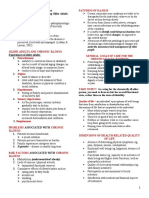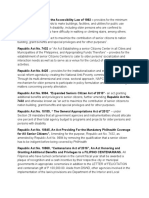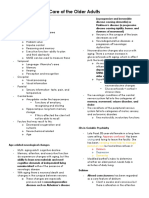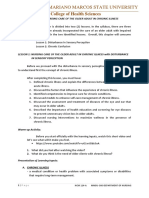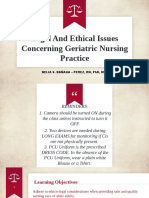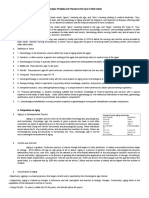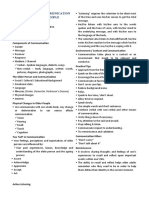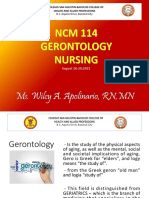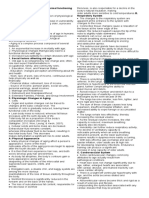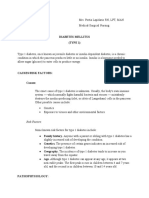0 ratings0% found this document useful (0 votes)
126 viewsNCM 114 Reviewer
NCM 114 Reviewer
Uploaded by
Lovely DaroleUnderstanding the geriatric population requires considering:
1) Biological changes that occur with aging and their effects on health needs. Common misconceptions about aging stem from cultural beliefs that view it only negatively.
2) Societal attitudes often stereotype older adults as sick, unproductive, and a burden. Understanding theories of aging can help address these misconceptions.
3) Functional ability varies more than chronological age. Those requiring daily help, termed "frail elderly," have greater health care needs and worse outcomes. Providing community services and support can help this group.
Copyright:
© All Rights Reserved
Available Formats
Download as DOCX, PDF, TXT or read online from Scribd
NCM 114 Reviewer
NCM 114 Reviewer
Uploaded by
Lovely Darole0 ratings0% found this document useful (0 votes)
126 views9 pagesUnderstanding the geriatric population requires considering:
1) Biological changes that occur with aging and their effects on health needs. Common misconceptions about aging stem from cultural beliefs that view it only negatively.
2) Societal attitudes often stereotype older adults as sick, unproductive, and a burden. Understanding theories of aging can help address these misconceptions.
3) Functional ability varies more than chronological age. Those requiring daily help, termed "frail elderly," have greater health care needs and worse outcomes. Providing community services and support can help this group.
Original Description:
k
Original Title
Ncm 114 Reviewer
Copyright
© © All Rights Reserved
Available Formats
DOCX, PDF, TXT or read online from Scribd
Share this document
Did you find this document useful?
Is this content inappropriate?
Understanding the geriatric population requires considering:
1) Biological changes that occur with aging and their effects on health needs. Common misconceptions about aging stem from cultural beliefs that view it only negatively.
2) Societal attitudes often stereotype older adults as sick, unproductive, and a burden. Understanding theories of aging can help address these misconceptions.
3) Functional ability varies more than chronological age. Those requiring daily help, termed "frail elderly," have greater health care needs and worse outcomes. Providing community services and support can help this group.
Copyright:
© All Rights Reserved
Available Formats
Download as DOCX, PDF, TXT or read online from Scribd
Download as docx, pdf, or txt
0 ratings0% found this document useful (0 votes)
126 views9 pagesNCM 114 Reviewer
NCM 114 Reviewer
Uploaded by
Lovely DaroleUnderstanding the geriatric population requires considering:
1) Biological changes that occur with aging and their effects on health needs. Common misconceptions about aging stem from cultural beliefs that view it only negatively.
2) Societal attitudes often stereotype older adults as sick, unproductive, and a burden. Understanding theories of aging can help address these misconceptions.
3) Functional ability varies more than chronological age. Those requiring daily help, termed "frail elderly," have greater health care needs and worse outcomes. Providing community services and support can help this group.
Copyright:
© All Rights Reserved
Available Formats
Download as DOCX, PDF, TXT or read online from Scribd
Download as docx, pdf, or txt
You are on page 1of 9
Understanding Geriatric Population
Consider the followings: Some myths, misconceptions and
1. Physiologic and biological changes that negative stereotypes about older
normally occur during aging. people stem from our culture’s
2. Understand older adult’s special health values and beliefs.
requirements. Many people perceived older adults
3. Help them learn to access community as senile, sick and incapable of
services, avoid falls, and deal with age- making worthwhile contributions to
related problems such as reduced visual society
acuity.
2. Fear of Aging
4. Understand the effects of prescription and
Most people don’t know enough about the
over- the- counter drugs on older patients
realities of aging; they fear death and,
in long- term care.
therefore, fear of growing older.
5. Equally importantly, you need to examine
GERONTOPHOBIA -refers to this fear &
your personal feelings about elderly people
the refusal to accept older people into the
to make sure that common misconceptions
mainstream of society.
about aging aren’t affecting the quality of
your care you provide.
2 extreme forms of Gerontophobia
6. You must consider end-of-life issues.
AGEISM- the negative stereotyping of
Important factors in understanding geriatric
aging and older persons, I a belief that
population
aging makes people unattractive,
1. Societal attitudes and beliefs unintelligent, and unproductive, it’s an
As a group, older adults in our emotional prejudice.
society are stereotyped. AGE DISCRIMINATION – it goes
Aging – is a natural process, but the beyond emotion; it’s the practice of treating
changes associated with it are rarely people differently simply because of their
viewed as natural or positive. age. (eg. Hiring, limited amount of health
Health care professional commonly care provided.)
described it as a “LOSSES” such as
(loss of tissue elasticity or a decrease What is aging?
The word “aging and old age are highly
I blood flow.)
subjective.
General, our society regards aging
It is defined as having lived for a long time
as:
and is commonly synonymous with negative
A series of inevitable,
terms, such as “ancient”, “antiquated”, and
negative events that a
“timeworn”.
person must tolerate
Its process is complex: it can be described
Health care professional
Chronologically
often mentioned age- related
Physiologically
changes and disease
And Functionally
conditions in the same
breath.
CHRONOLOGICAL AGE
-refers to the number of years a person has lived. Strong chemical bonding between organic
- Age 65 became the maximum age of eligibility for molecules in the body causes increase
retirement benefits stiffness, chemical instability, and
-65 is the accepted age for status as a senior citizen insolubility of connective tissues
deoxyribonucleic acid.
There are 3 chronological categories Sources;
Young- old (age 65 to 74) Lipids, proteins, carbohydrates, and nucleic
Middle-old (age 75 to 84) acid.
Old-old (ages 85 and older) Retardants;
Restricting calories and lathyrogens (anti-
PHYSIOLOGIC AGE link agents)
-refers to the determination of age by body
function. 2. Free radical-theory
Increased unstable free radical produced
FUNCTIONAL AGE harmful to biological system, such as
-refers to a person’s ability to contribute to chromosomal changes, payment to
society and benefit others and himself. accumulation.
- Those who require help are called – FRAIL
Sources;
ELDERLY
Environmental pollutants, oxidation of
(Note: not all individuals of the same
dietary fat, protein, carbohydrates.
chronological age function at the same level.)
Retardants;
-age 75 is the fastest growing segment of the older
Improving environmental monitoring;
population.
decreasing of free- radical stimulating
-age 75to 84 – about 25% need help with ADL
foods; increase intake of vitamin of A & C
-Age 85 and older – nearly ½ need help with ADL.
Mecarplans and vitamin E
Characteristic common to the frail elderly
3. Immunologic theory
o Poor mental and physical health
o An aging immune system is less able to
o Low socioeconomic status
distinguish body cells from foreign cells; as
o Female gender (predominantly)
a result, it begins to attack and destroy
o Isolated living conditions (possibly)
body cells as if they were foreign.
o More & longer hospital stays with more
o This may explain the adult onset of such
money spent on health care & drugs
conditions as diabetes mellitus, rheumatic
o More frequent visit to the doctors
heart disease, and arthritis. Theorists have
o More use of nursing home beds than
speculated about several erratic cellular
hospital beds. mechanisms capable of precipitating attack
on various tissues through auto aggression
Theories of aging or immunodeficiency’s.
Sources;
A. BIOLOGICAL THEORIES Alteration of B and T cells of the humoral ad
1. Cross-link theory cellular system.
Retardants;
Considering and immuno-engineering- Taking into account the impact major
selective alteration replenishment or societal changes, this can alter individual
rejuvenation of the immune system. expectations and behavior.
4. wear and tear theory 3. Disengagement theory
Body cells, structures, and functions wear Progressive social disengagement occurs with
out or are overused through exposure to age.
internal and external stressors. Effects from Sources;
residual damage accumulate, the body can Decrease participation in society resulting
longer resist stress and death occurs. from age-related changes in health, energy,
Sources; income, and social roles.
Repeat injury or overuse; internal and Retardants;
external stressors (Physical, Psychological, Taking into account diversity of individual
social, and environmental, including outlook and lifestyle and social structure
trauma, chemicals, and buildup of naturally variables, such as economy and social
occurring wastes. organizations.
Retardants;
Reevaluating and possibly adjusting
4. Social exchange theory
lifestyle.
Social behavior involves doing what’s
A. PSYCHOSOCIAL THEORIES valued and rewarded by society.
1. Activity theory
Successful aging and life satisfaction depend Sources;
on maintaining a high level of activity. Diminished resources and increase
Sources; dependency leading to unequal
Quality and meaningfulness over quantity contribution to society and reduced power
of activities; life satisfaction related to and value; decreased number of roles
involvement in life. available in society.
Retardants; Retardants;
Increasing activities in other areas when Assuming new roles and friendship with
activities in one area decrease. other older adults to help socialize the
person and help the person adjust to age-
2. Continuity theory related norms.
An individual remains essentially the same,
despite life changes. This theory focuses Notes:
more on personality and individual behavior Aging is a normal part of human developmental.
over time. Various theories have been proposed;
1. To explain the process of normal aging and
Sources; help dispel some of the myths.
Assumed stability of individual patterns or 2. Provide guidelines to determine how well a
orientation over time. patient is adjusting to aging.
Retardants;
3. Identify areas that need to be assessed and 3. It’s equally important for you to recognize
provide a basis for interventions and that even laboratory test values will change
rationales in nursing care. to reflect the aging process.
4. (No single theory of aging is universally 4. Values considered abnormal in younger
accepted.) adults may be normal in older adults.
Understanding the normal aging process
Biological theories can help you understand why a person’s
Attempt to explain physical aging as an risk of developing certain disease and
involuntary process, which eventually leads to sustaining injuries increase over time
cumulative changes in cells, tissues, and fluids.
Intrinsic biological theory maintains that aging Nutrition
changes arise from internal, predetermined causes. A person’s protein, vitamin, and mineral
Extrinsic biological theory maintains that requirements usually remain the same as he/she
environmental factors lead to structural alterations ages, but caloric need decrease. Diminished activity
which, in turn, cause degenerative changes. may lower energy requirements by about;
MEN & WOMEN- 200 Calories /day ages 51 to 75
Psychological theories Men - 500 Calories/day age over 75
It attempts to explain age-related changes Women - 400 calories/day age over 75
in cognitive function, such as intelligence, memory,
learning, and problem solving. Other physiologic changes that can affect
nutrition in an older patient.
Sociologic theories o Decrease renal function an, causing greater
It attempts to explain changes that affect susceptibility to dehydration and formation of
socialization and life satisfaction. It maintains that a renal calculi
social expectation change, people assume new o Loss of calcium and nitrogen (patient isn’t
roles, which leads to changes in identity. ambulatory)
o Diminished enzyme activity and gastric
Developmental theories
secretions
Describe specific life stages and tasks
o Reduced pepsin and hydrochloric acid
associated with each stage.
secretions, which tends to diminish the
absorption of calcium and vitamins B1 and B2.
Physiologic Changes of Aging
o Decrease salivary flow and diminish sense of
1. Aging is characterized by the loss of some
taste which may reduce the person’s appetite
body cells and related metabolism in other
and increase his consumption of sweet, salty,
cells. This process results in a decline in
and spicy foods.
bodily function and changes in body
o Diminished intestinal motility and peristalsis of
composition.
the large intestine
2. It’s important for you to recognize the
o Thinning of tooth enamel, causing teeth to
gradual changes in body function that
become more brittle
normally accompany aging so that you can
o Decrease biting force
adjust your assessment techniques
o Diminish gag reflex.
accordingly.
Some common condition found in older people o Weakened chest musculature re person’s
can affect nutritional status: reduces an older ability to clear lung secretions
1. Limiting patient’s mobility and increase high risk of developing
2. Diminished intestinal motility -may cause GI pneumonia, tuberculosis, and other respiratory
disorders like constipation & fecal diseases.
incontinence o In older men, prostatic hypertrophy is a
3. Suffer constipation – cause by nutritionally common cause of urinary tract obstruction and
inadequate diet of soft, refined foods low in acute urine retention.
dietary fiber, physical inactivity, emotional o A weakened immune system increases an older
stress or certain medications. debilitated person’s risk of Acquiring almost
4. Laxative abuse -cause rapid transport of any infection to which he’s exposed.
food through GI tract, decreasing digestion
and absorption. DIFFERENT BODY SYSTEMS
INVOLVE IN THE PROCESS OF CHANGES
Socioeconomic & psychological factors that affect
nutritional status: Age- related adjustment and transitions
o Loneliness The aging process is accompanied by role changes
o Decline of role & importance in the family and transitions:
o Lack of money Factors;
o Transportation to buy nutritious foods. Family role
Age, sex, beliefs, attitudes, income, health, and
ILLNESS AND INJURY: WHY THE RISK past experience
INCREASE WITH AGE Culture (illness, dependence/interdependence,
o Decreased cerebral blood flow increases the roles changes, losses an death in a context
risk of stroke. that’s unique to their culture)
o An older person’s spinal cord is tightly encased ROLE CHANGES - depends on the situation
in vertebrae that may stud with bony spurs or where in and varies.
shrunken around the cord. Even minor fall can RETIREMENT
cause sever cord damage. MULTIPLE LOSSES
o In older women, osteoporosis cause LONELINESS
compression fractures even without a history of DEPRESSION AND SUICIDE
trauma
o Brittle bones make an older person especially Clinical Alert! :
prone to fractures. Falling on an outstretched Suicidal rate in older adult men is seven
arm or hand or experiencing a direct blow to times that of women, an is rarely an
the arm or shoulder and is likely to fracture the impulsive act, most suicide attempts aren’t
shoulder or humerus. gestures or threats
o Diminished heart rate and stroke volume place Risk factors include;
an older person at risk for developing heart Alcoholism
failure, hypertensive crisis, arterial occlusion, Bereavement
and myocardial infarction. Loss of health, loss of role
Living alone
And children who have married and moved o Maximum breathing capacity, forced vital
away. capacity, and inspiratory reserve volume
diminished with age, leaving the patient with
lowered tolerance for oxygen debt.
DIFFERENT ORGAN/ BODY SYSTEMS
Cardiovascular system
Respiratory system Heart usually becomes slightly smaller and
Age-related anatomic changes in the upper airways loses its contractile strength and efficiency.
include: (Exception occurs with people with hypertension or
o Nose enlargement from continued cartilage heart disease.)
growth o By age 70, cardiac output at rest diminished by
o General atrophy of the tonsils about 30% to 35% in many people.
o Tracheal deviations from changes in the aging o Fibrotic and sclerotic changes thicken heart
spine valves and reduce flexibility, leading to rigidity
o Thoracic changes – anteroposterior chest and incomplete closure of the heart valves,
diameter, as a result of altered calcium which may result in systolic murmurs.
metabolism and calcification of costal o Thickness of the left ventricular wall increase by
cartilages, which reduces mobility of the chest 25% between age 30 and 80
wall. o Develop obstructive coronary disease and
o KYPHOSIS advances with age because of such fibrosis of the cardiac skeleton.
factors as osteoporosis and vertebral collapse. o Hearts become irritable, extra systoles may
diminishes ventilator capacity for the occur, along with sinus arrhythmias and sinus
following reasons: bradycardias.
1. lungs’ diffusing capacity declines o Increase fibrous tissue infiltrates the sinoatrial
decreases inspiratory and node and internodal atrial tracts, which may
expiratory muscle strength cause atrial fibrillation and flutter.
diminishes vital capacity o Vein dilates and stretch
2. Lung tissue degeneration causes a o Coronary artery blood flow decreases by 35 %
decrease in the lung’s volume, thus
between age 20 and 60.
aging alone can cause EMPHYSEMA.
o Aorta becomes more rigid, causing systolic
o Closing of some airways causing poor
blood pressure to rise disproportionately higher
ventilation of the basal areas, resulting I both a
than the diastolic, resulting in a widened pulse
decreased surface area for gas exchanges and
pressure.
reduced partial pressure of oxygen (PO2)
o ECG (electrocardiogram)changes include
o Normal partial pressure of a capacity, arterial
increase PR, QRS, and QT intervals
oxygen (PaO2) decrease to 70 to 85 mmHg.
o Decrease amplitude of the QRS complex, and
o Oxygen saturation decrease by 5%. Lung
shift of the QRS axis to the left.
becomes more rigid, and the number and size
o Decrease ability to respond to physical and
of alveoli decline with age.
emotional stress.
o A 30% reduction in respiratory fluids heightens
o Heart rate takes longer to return to normal
the risk of pulmonary infection and mucus plug.
after exercise.
o Arterial and venous insufficiency as the o Impaired renal clearance of drugs
strength and elasticity of blood vessel decrease. o Reduced bladder size and capacity
o o Decreased renal ability to respond to
o This contributes older people increased variations in sodium intake
incidence of cardiovascular disease, particularly o By age 70, blood urea nitrogen levels rise by
coronary disease. 21%
o Residual urine, frequency and nocturia also
increase with age.
Gastrointestinal system
Aging are usually less debilitating to the GI system
Male reproductive system
than the other system. This includes the ff:
o Reduced testosterone production – which
o Diminished mucosal elasticity and reduced
in turn may cause the ff:
GI secretions, which in turn modify same
decrease in libido, testes become atrophy,
process like digestion and absorption.
soften&
o Decrease in GI tract motility, bowel wall and
Decreases sperm production by 48 % to
anal sphincter tone & abdominal muscle
67% between age 60 and 80.
strength- may cause complaints in ranging
o Prostate glands enlarge with age and its
from loss of appetite to constipation that
secretion diminishes.
may increase too as related to use of
o Decrease in seminal fluid, volume and less
multiple medications-common to older
viscous.
people.
o Decrease in liver weight, reduced
Female reproductive system
regenerative capacity
Declining estrogen and progesterone levels cause a
o Decreased blood flow to the liver- because
number of physical changes.
hepatic enzymes involved in oxidation and o It includes emotional & physical changes
reduction markedly decline with age.
o Transition from childbearing years to
o Liver metabolizes drugs and detoxifies
infertility.
substances becomes less efficient.
o As estrogen level decrease, menopausal
period approaches about age 50.
Renal system
OVARIES
o Renal function diminishes after age 40. If
-Ovulation usually stops 1 to 2 years before
the person lives to age 90 it may have
menopause.
decreased by as much as 50% - this due to
-They become unresponsive to gonadotropic
the decline in the glomerular filtration rate.
simulation.
o Decrease renal blood flow by 53% from
-Ovaries become atrophy, thicker and smaller.
reduced cardiac output and age-related
atherosclerotic changes.
VULVA
o Bladder muscles weaken- may results in
-The vulva atrophies with age.
incomplete bladder emptying -Pubic hair loss and flattening of labia majora
o Chronic urine retention- predisposing the -Vulva tissue shrinks- thus exposing the sensitive
bladder to infection. area around the urethra and Vagina to abrasions
o Diminished kidney size and irritation (e.g. Undergarments)
-introitus constricts Difficulty in rising from a chair
-tissues lose their elasticity and epidermis thin from Urinary stress incontinence occurs -if
20 layers to about 5. urethrovesical ligaments weaken.
VAGINA Neurologic system
-The vagina shortens and the mucous lining to o Neurons of the central and peripheral nervous
become thin, dry, less elastic and pale as a results systems undergo degenerative changes.
of decrease vascularity – due to atrophy. o Nerve transmission slows down- causing the
-susceptible to abrasion older people to react more slowly to external
-The pH of vaginal secretions increases making the stimuli.
vagina environment more alkaline. o After about age 50, the number of brain cells
-Flora changes causing increase in vaginal decreases at a rate of about 1% per year.
infections. o (note: Clinical effects usually aren’t noticeable
until aging is considerably more advanced)
UTERUS o Hypothalamus becomes less effective at
-After menopause, the uterus shrinks rapidly to regulating body temperature.
one-half its premenstrual weight to approximately o Cerebral cortex undergoes 20% neuron loss
one-fourth its premenstrual size. o Corneal reflex becomes slower, and the pain
-Atrophy of the cervix and no longer produces threshold increases
mucus for lubrication o Experiences a decrease in stages III and IV
-Endometrium and myometrium become thinner sleep- causing frequent awakening;
o Rapid eye-movement sleep decreases –
BREAST results in increased need for rest during the
-Atrophy of glandular, supporting, and fatty tissues day.
-Cooper’s ligament lose their elasticity
-Pendulous breast Musculoskeletal system
-decrease in nipple size and becomes flat o Increase adipose tissue
-Fibrocystic disease present at menopause o Diminish lean mass and bone mineral contents
diminishes o Height decrease – may results in exaggerated
- Inframammary ridges become more pronounced.
spinal curvatures and narrowing intervertebral
PELVIC SUPPORT STRUCTURES
spaces, which shorten the trunk and make the
(Relaxation of structures commonly occurs among
arms, appear relatively long.
post reproductive women. Initially occurs during
o Decrease bone and muscle mass causing
labor & delivery, but clinical effects go unnoticed
muscle weakness
until the process accelerates with menopausal
o And collagen formation causing loss of
estrogen depletion and loss of connective elasticity
resilience and elasticity in joints and supporting
and tone.)
structures
Signs and Symptoms:
o Synovial fluid more viscous and synovial
Pressure and pulling in the area above the
membranes become more fibrotic
inguinal ligaments
o Difficulty in tandem walking
Low backache
A feeling of pelvic heaviness
o Walks in shorter steps and wider leg stance to
achieve better balance and stable weight
distribution.
You might also like
- Handbook of Acoustics by Crocker, Malcolm J. PDFDocument1,398 pagesHandbook of Acoustics by Crocker, Malcolm J. PDFExrtra Terrestrial100% (1)
- Care of The Older Adult l1 l2Document7 pagesCare of The Older Adult l1 l2ELVINCE LACPAONo ratings yet
- A To Z of Steam Turbine Maintenance PDFDocument157 pagesA To Z of Steam Turbine Maintenance PDFivaturi100% (3)
- Care of The Older Adult in WellnessDocument67 pagesCare of The Older Adult in WellnessShazich Keith Lacbay100% (3)
- Lesson 2 Implementation of Nursing Care of The Older AdultDocument10 pagesLesson 2 Implementation of Nursing Care of The Older Adultczeremar chanNo ratings yet
- AmlDocument12 pagesAmlireshaNo ratings yet
- NCM 114 Care For Older Adults MODULE 4Document5 pagesNCM 114 Care For Older Adults MODULE 4Meryville JacildoNo ratings yet
- Care of The Older Adult Handouts PrelimsDocument7 pagesCare of The Older Adult Handouts PrelimsAmanda Joy TuizaNo ratings yet
- Laws Affecting Senior CitizenDocument12 pagesLaws Affecting Senior CitizenGiselle EstoquiaNo ratings yet
- Geria UNIT 3Document5 pagesGeria UNIT 3Raiden VizcondeNo ratings yet
- NCM114 - Learn Mat 1 2021Document32 pagesNCM114 - Learn Mat 1 2021jjNo ratings yet
- Nursing Care of The Older Adult in Chronic Illness JCC Converted 1Document41 pagesNursing Care of The Older Adult in Chronic Illness JCC Converted 1Amelite Meriño0% (1)
- Care of Older Adults (Finals)Document14 pagesCare of Older Adults (Finals)Ax’l SisterNo ratings yet
- Chapter 3-GERIADocument25 pagesChapter 3-GERIA3D - AURELIO, Lyca Mae M.No ratings yet
- Ethicolegal Issues in The Care of The ElderlyDocument36 pagesEthicolegal Issues in The Care of The ElderlyNhelia Santos BañagaNo ratings yet
- NCM 114 MidtermDocument10 pagesNCM 114 MidtermJULIANNAH ATHENA MERCADONo ratings yet
- Care of Older Adults (Prelims)Document12 pagesCare of Older Adults (Prelims)Ax’l SisterNo ratings yet
- Nursing Care of The Older Patient in Chronic IllnessDocument40 pagesNursing Care of The Older Patient in Chronic IllnessMaggay LarsNo ratings yet
- Nursing Care of The Older Adult in Chronic IllnessDocument19 pagesNursing Care of The Older Adult in Chronic IllnessWen Silver100% (1)
- Group 1 Physiological Changes in Aging Affecting Various SystemsDocument22 pagesGroup 1 Physiological Changes in Aging Affecting Various SystemsIra LampayanNo ratings yet
- Nursing Care of Older Adults in WellnessDocument26 pagesNursing Care of Older Adults in WellnessAlex Mendoza100% (1)
- GERIARTRICSDocument4 pagesGERIARTRICSLoribel Coma100% (2)
- Communication: Module 8 (PPT) : Communication With Older PeopleDocument1 pageCommunication: Module 8 (PPT) : Communication With Older PeopleRyrey Abraham Pacamana100% (1)
- NCM 114 Gerontology - WeeK 1Document38 pagesNCM 114 Gerontology - WeeK 1Jmarie Brillantes Popioco0% (1)
- NCM 114 Care For Older Adults MODULE 6Document2 pagesNCM 114 Care For Older Adults MODULE 6Meryville JacildoNo ratings yet
- NGCM 112 Course OutlineDocument7 pagesNGCM 112 Course OutlineAYTONA, JAMAICA F.No ratings yet
- NCM 114 Lesson 1Document10 pagesNCM 114 Lesson 1Maia Saivi OmegaNo ratings yet
- NCM 114 Midterm ReviewerDocument9 pagesNCM 114 Midterm ReviewerAngelicaNo ratings yet
- 1 Gerontology Nursing Concepts: Gloria P. de Leon, RN, RM, ManDocument211 pages1 Gerontology Nursing Concepts: Gloria P. de Leon, RN, RM, ManJohanine VillasantiagoNo ratings yet
- Demographics of AgingDocument19 pagesDemographics of AgingAnalyn SarmientoNo ratings yet
- Handout 2 - Care of The Older Person-Ncm 114 Care of The Older AdultDocument6 pagesHandout 2 - Care of The Older Person-Ncm 114 Care of The Older Adultkaycelyn jimenez100% (1)
- Theories of Aging in NursingDocument2 pagesTheories of Aging in NursingLieana AguilarNo ratings yet
- Commission On Higher Education Center of Excellence in Nursing EducationDocument9 pagesCommission On Higher Education Center of Excellence in Nursing EducationR-Chian Jose GermanpNo ratings yet
- Bioethics Final Lecture 1Document45 pagesBioethics Final Lecture 1hanna castueraNo ratings yet
- Ethico Legal Considerations in The Care of Older AdultsDocument41 pagesEthico Legal Considerations in The Care of Older AdultsGleza MirallesNo ratings yet
- CIP-NCM-121-Disaster Nursing-TuesdaysDocument3 pagesCIP-NCM-121-Disaster Nursing-TuesdaysKhen QuiringNo ratings yet
- Module 1 18 - NCM 114.Document40 pagesModule 1 18 - NCM 114.Darrel AlilingNo ratings yet
- Syllabus NCM114 Care of The Older AdultDocument12 pagesSyllabus NCM114 Care of The Older AdultAnne LauretaNo ratings yet
- NCM 108 Bioethics - Finals NotesDocument7 pagesNCM 108 Bioethics - Finals NotesPauline AñesNo ratings yet
- Learning Objectives: Introduction To Gerontological NursingDocument12 pagesLearning Objectives: Introduction To Gerontological NursingArlyn MendenillaNo ratings yet
- Health Care EthicsDocument12 pagesHealth Care EthicsAnntel RoseNo ratings yet
- Community Health Nursing IIDocument21 pagesCommunity Health Nursing IIbrigeacunaNo ratings yet
- NCM 217 SKILLS LAB Maladpative Nursing 3Document60 pagesNCM 217 SKILLS LAB Maladpative Nursing 3Sophia IbuyanNo ratings yet
- Geria (Midterms)Document42 pagesGeria (Midterms)ANGELA GLORIA LAPUZNo ratings yet
- Day 1 - Definition of TermsDocument18 pagesDay 1 - Definition of TermsShy Dela PuertaNo ratings yet
- NCM 114 Module 1Document7 pagesNCM 114 Module 1Roel John Atamosa CasilacNo ratings yet
- Lesson 6 Bioethics and Its Application in VariousDocument19 pagesLesson 6 Bioethics and Its Application in VariousJoycee BoNo ratings yet
- PWU NCM 114 - Care of The Older Person 3Document34 pagesPWU NCM 114 - Care of The Older Person 3Ira AnuddinNo ratings yet
- NCM118 Altered Ventilatory FunctionDocument27 pagesNCM118 Altered Ventilatory Functionmirai desuNo ratings yet
- NCM 117 Week 3 Personality Theories and Determinants of Psychopathology (20230225202203) PDFDocument90 pagesNCM 117 Week 3 Personality Theories and Determinants of Psychopathology (20230225202203) PDFJohn Rey Operaña IINo ratings yet
- Learning Module in NCM 114Document28 pagesLearning Module in NCM 114JIMENEZ, TRISHA MARIE D.No ratings yet
- Geria Prelim 1 1Document48 pagesGeria Prelim 1 1SVPSNo ratings yet
- NCM 112 Trinal 9Document6 pagesNCM 112 Trinal 9Marielle ChuaNo ratings yet
- Geria Lec Portfolio CasiaDocument9 pagesGeria Lec Portfolio CasiaMarie Ashley CasiaNo ratings yet
- Ethico-Legal Considerations in The Care of Older AdultDocument25 pagesEthico-Legal Considerations in The Care of Older AdultMarlone James OcenaNo ratings yet
- Tagum Doctors College, Inc.: Mahogany ST., Rabesubd., Tagum City E-MailDocument4 pagesTagum Doctors College, Inc.: Mahogany ST., Rabesubd., Tagum City E-MailRoel John Atamosa CasilacNo ratings yet
- 2.mod Geron 2 DocumentationDocument43 pages2.mod Geron 2 Documentationnot your medz duran100% (1)
- Lesson 12: Factors That Affect Normal Functioning of The Older Persons Aging Respiratory SystemDocument13 pagesLesson 12: Factors That Affect Normal Functioning of The Older Persons Aging Respiratory SystemSamantha Bolante100% (1)
- NCM 108 Health Care Ethics MidtermDocument70 pagesNCM 108 Health Care Ethics MidtermMaria Arlyn Lacuña SagosoNo ratings yet
- Unit 5 EDITEDDocument38 pagesUnit 5 EDITEDKaye ViolaNo ratings yet
- NCM 117 Week 4 Personality Theories and Determinants of Psychopathology Part 1 (20230218211700) PDFDocument50 pagesNCM 117 Week 4 Personality Theories and Determinants of Psychopathology Part 1 (20230218211700) PDFJohn Rey Operaña IINo ratings yet
- Module 2 HandoutsDocument9 pagesModule 2 HandoutsEdelrose LapitanNo ratings yet
- Ventricular Septal Defect, A Simple Guide To The Condition, Treatment And Related ConditionsFrom EverandVentricular Septal Defect, A Simple Guide To The Condition, Treatment And Related ConditionsNo ratings yet
- Diabetes Mellitus (TYPE 1) : Risk FactorsDocument8 pagesDiabetes Mellitus (TYPE 1) : Risk FactorsLovely DaroleNo ratings yet
- Child and Adolescent Learners and Learning Principles - 091110Document80 pagesChild and Adolescent Learners and Learning Principles - 091110Lovely DaroleNo ratings yet
- Chapter 1 The Human Communication Process in Context Copy (1) 112452Document65 pagesChapter 1 The Human Communication Process in Context Copy (1) 112452Lovely DaroleNo ratings yet
- Managing Urinary Tract Problem: FOCUS On The FollowingDocument11 pagesManaging Urinary Tract Problem: FOCUS On The FollowingLovely DaroleNo ratings yet
- Pathophysiology: Cholecystitis Non Modifiable Factors Modifiable FactorsDocument4 pagesPathophysiology: Cholecystitis Non Modifiable Factors Modifiable FactorsLovely DaroleNo ratings yet
- Community Health Survey FormDocument5 pagesCommunity Health Survey FormLovely DaroleNo ratings yet
- Pathophysiology CholelithiasisDocument2 pagesPathophysiology CholelithiasisLovely DaroleNo ratings yet
- Faleo - La: Filipino American Law Enforcement Officers Association, Los AngelesDocument5 pagesFaleo - La: Filipino American Law Enforcement Officers Association, Los AngelesLovely DaroleNo ratings yet
- Static Routing Packet TracerDocument4 pagesStatic Routing Packet Tracerfalaad64No ratings yet
- Electrical Layout: SpecificationDocument1 pageElectrical Layout: SpecificationREX AMPONGANNo ratings yet
- Scenario 6 Bug Hunt Part 4Document2 pagesScenario 6 Bug Hunt Part 4BlackdogzxNo ratings yet
- Fire Safety Easy Quiz - BrainPOP JRDocument1 pageFire Safety Easy Quiz - BrainPOP JRleduylamNo ratings yet
- History: Wild AncestorsDocument2 pagesHistory: Wild AncestorspriyankaNo ratings yet
- 1st Prelim EconDocument3 pages1st Prelim Econmharjun lampaNo ratings yet
- Results 2022 World Triathlon Cup HuatulcoDocument2 pagesResults 2022 World Triathlon Cup HuatulcoBernewsAdminNo ratings yet
- De Thi Giao Luu Hoc Sinh Gioi Cap Tinh Mon Tieng Anh 9 Nam 2018 2019 Co Dap An So GD DT Thanh HoaDocument7 pagesDe Thi Giao Luu Hoc Sinh Gioi Cap Tinh Mon Tieng Anh 9 Nam 2018 2019 Co Dap An So GD DT Thanh HoavietanhnotgayNo ratings yet
- Richemont Securities SA - Richemont Annual General Meeting Updated Voting InstructionsDocument6 pagesRichemont Securities SA - Richemont Annual General Meeting Updated Voting InstructionsD_E_V_ZNo ratings yet
- Ref. No. 257, S. 2019 - Submission of Participants To The Division Teacher Induction Program (TIP) 2019 PDFDocument17 pagesRef. No. 257, S. 2019 - Submission of Participants To The Division Teacher Induction Program (TIP) 2019 PDFChristine SalientesNo ratings yet
- Enraf 682 Manual EnglishDocument106 pagesEnraf 682 Manual EnglishMintflex PhysiotherapyNo ratings yet
- NESPAK Internship ReportDocument21 pagesNESPAK Internship Reportaalamz93_85491725450% (2)
- Amniotic Fluid Sludge Is Associated With Earlier Preterm Delivery and Raised Cervicovaginal Interleukin 8 ConcentrationsDocument7 pagesAmniotic Fluid Sludge Is Associated With Earlier Preterm Delivery and Raised Cervicovaginal Interleukin 8 ConcentrationsShinta Dewi WulandariNo ratings yet
- Distant View From Outside To Inside The Squence of Spaces Edges, Nodes & Termination of The Paths Corridors, Halls, Staircases, Lifts, EtcDocument1 pageDistant View From Outside To Inside The Squence of Spaces Edges, Nodes & Termination of The Paths Corridors, Halls, Staircases, Lifts, EtcChopra ShubhamNo ratings yet
- Atomic Absorption Spectroscopy - University NotesDocument29 pagesAtomic Absorption Spectroscopy - University NotesLilac44No ratings yet
- IveyMBA Permanent Employment ReportDocument13 pagesIveyMBA Permanent Employment Reportelton6henriquesNo ratings yet
- Ethiopia Import Export Sample ReportDocument10 pagesEthiopia Import Export Sample ReportChuchure TekaNo ratings yet
- PresentationsDocument1 pagePresentationsMadina SaparbaevaNo ratings yet
- Hooks DynaplexDocument8 pagesHooks DynaplexjohangomezruizNo ratings yet
- Parametric Design of Sailing Hull Shapes: Antonio MancusoDocument13 pagesParametric Design of Sailing Hull Shapes: Antonio MancusolavrikNo ratings yet
- Cheat Codes For Pokemon Mystery Dungeon - Explorers of Time On Nintendo DS - Codejunkies US9Document2 pagesCheat Codes For Pokemon Mystery Dungeon - Explorers of Time On Nintendo DS - Codejunkies US9degraded 4resterNo ratings yet
- Mechanics: Classical Versus QuantumDocument11 pagesMechanics: Classical Versus QuantumJaneeshVargheseNo ratings yet
- Machine Profiles: D10R Track-Type TractorsDocument5 pagesMachine Profiles: D10R Track-Type TractorsJavier Pagan TorresNo ratings yet
- Sommer DDocument2 pagesSommer Dapi-295336875No ratings yet
- CustomersDocument109 pagesCustomersOmar NoahNo ratings yet
- Tomba Et Al-2018-Journal of Raman SpectrosDocument11 pagesTomba Et Al-2018-Journal of Raman SpectrosDaniel MontalvoNo ratings yet
- Uninstall Instructions 1) How To Uninstall VdownloaderDocument1 pageUninstall Instructions 1) How To Uninstall Vdownloaderomshuavatar4682No ratings yet






